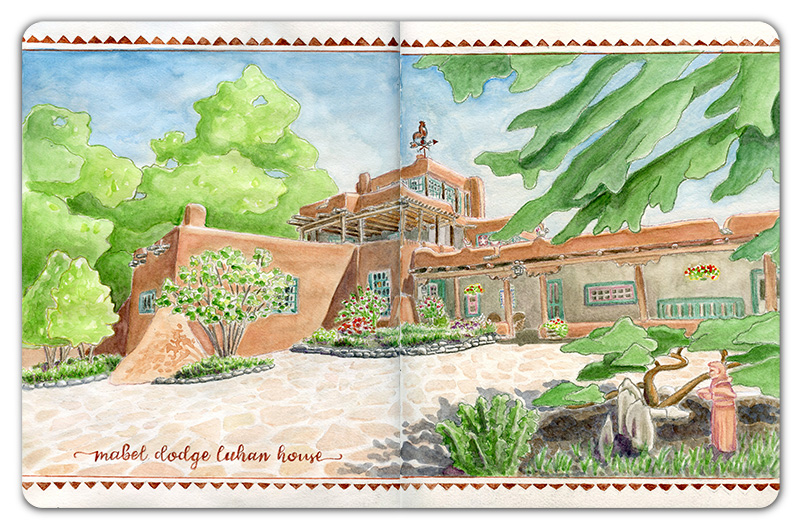"There are doors that feel as though they're leading you,
pulling you, to somewhere enchanting". ―HeartFireAtHome
pulling you, to somewhere enchanting". ―HeartFireAtHome
There are three reasons I began this project. First, I wanted to get rid of the old, cracked concrete paint that has greeted us for twenty years on our front doorstep. Second, I wanted the step to match not only the painted lintels of the windows on either side of the door... but also the recently added folk-painted shutters on the second floor dormer windows (click here to see them.) And the final reason is that I have been attempting to make my inner appearance match my outer appearance on all levels of being...I know...a lofty goal.
I have always wanted my house to be a reflection of myself. When I thought about adding a painted stencil to the entryway, it made me think about doorways and what they mean. I asked myself the question, "What would a folk-painted doorstep imply to someone entering or exiting my house?" What came to me was "When you enter this house, you are entering a magical space." I wanted the step to welcome people into our home and to communicate that you are entering a sacred, enchanting, and delightful abode.
And it occurred to me the same was true in reverse,..."When you are leaving the house and stepping out into the world, you are entering a magical space." Every time a person leaves the house, the step is a reminder that the world is full of splendor, if one has eyes to see it. In a sense, the step would be a visual mantra to look for beauty on one's path. You are entering a magical space whether you are coming or going!
"The door is always a threshold for wonder". ― Unknown
PROCESS
Old Paint Removal
When we bought our house twenty years ago the front porch was covered in old, chipping concrete paint. Just last year we paid a contractor to remove the paint. They were not overly successful and did not scrape the entryway step at all.
So, for my birthday this year, George borrowed my neighbor's heated paint remover (thank you Mark) and spent many hot days trying to remove the paint. It was not easy, but it is one of the best birthday gifts a girl could get IMHO!
PAINTING THE STEP
I spent A LONG time chatting with the man at Sherwin Williams about the best paint to use. He told me not to use a primer if people would be stepping on the paint, and to simply use their floor paint straight onto the stone. One problem we encountered was the floor paint color match was not the greatest. I took the paint that we used on the lintels and they tried to color match it, but the base used for floor paint was a little different. You can sort of see in the photo below, the step paint was more "purplely." I ended up buying two different colors and mixing them to try to remedy the situation. In the end it worked OK, but I wish I had made more to use to seal the stencils. I just barely had enough.
So, for my birthday this year, George borrowed my neighbor's heated paint remover (thank you Mark) and spent many hot days trying to remove the paint. It was not easy, but it is one of the best birthday gifts a girl could get IMHO!
PAINTING THE STEP
I spent A LONG time chatting with the man at Sherwin Williams about the best paint to use. He told me not to use a primer if people would be stepping on the paint, and to simply use their floor paint straight onto the stone. One problem we encountered was the floor paint color match was not the greatest. I took the paint that we used on the lintels and they tried to color match it, but the base used for floor paint was a little different. You can sort of see in the photo below, the step paint was more "purplely." I ended up buying two different colors and mixing them to try to remedy the situation. In the end it worked OK, but I wish I had made more to use to seal the stencils. I just barely had enough.
The first step was determining the location of the stencil. I measured the entire step and put the middle flower exactly in the center. If I had it to do over again, I might have centered the whole thing where the two doors meet, which was slightly different. In the end no one will notice but me. But it's something to think about if you are reading this and considering your own project. Please note my adorable supervisor inside...also, yes, I am wearing my ridiculous mosquito net getup because they were eating me alive!
Base coat
The next step, which is super important, was to paint a layer of the base paint color. This helps to seal the stencil and prevent leakage of the colors beneath the stencil. (I have also read you can use Mod Podge for this.)
Thin layers
It is also best to do thin layers of paint. I did three layers and later learned it is best not to let things sit too long. Do each layer as soon as the paint dries and then take it off ASAP!
Remove stencil
Below you can see the first stencil worked fairly well, with only a few spots needing touch-up.
Clean stencil
I planned the design so that I could flip the stencil around to the left side and line up the flower. I spent a LONG time scraping the paint off the stencil using an old credit card. When George got home he said, "You could have just rotated the stencil instead of flipping it over." I don't know why that hadn't occurred to me. But as I found out later, it is always a good idea to clean the stencil even if you simply rotate it (or make multiple stencils!).
Base coat
The next step, which is super important, was to paint a layer of the base paint color. This helps to seal the stencil and prevent leakage of the colors beneath the stencil. (I have also read you can use Mod Podge for this.)
It is also best to do thin layers of paint. I did three layers and later learned it is best not to let things sit too long. Do each layer as soon as the paint dries and then take it off ASAP!
Remove stencil
Below you can see the first stencil worked fairly well, with only a few spots needing touch-up.
“You who long to step over this threshold, do you know what awaits you?”
― Ivan Turgenev
Clean stencil
I planned the design so that I could flip the stencil around to the left side and line up the flower. I spent a LONG time scraping the paint off the stencil using an old credit card. When George got home he said, "You could have just rotated the stencil instead of flipping it over." I don't know why that hadn't occurred to me. But as I found out later, it is always a good idea to clean the stencil even if you simply rotate it (or make multiple stencils!).
Here you can see the stencil rotated and ready for the next round of paint layers.
Front stencil done!
I was pretty happy with the way everything went on the front stencil. There were touch-ups to be done, but overall things went pretty smoothly.
After completing the top stencil on the right-hand side I decided to chance it and not clean the stencil before using it on the left-hand side.
Stencil disaster!
As you can see below, I had what I would call a stencil disaster. When I went to remove the stencil it was seriously stuck. When I tried pulling on it, I could see the paint was stretching the design and even pulling up the base paint! I was a bit distracted because George was making a video of me pulling it off. I probably should have stopped sooner and gotten an exacto blade...which I eventually did...but not before causing some damage. It did help tracing around the edge of the stencil with the exacto knife, but I didn't like cutting through all the layers for longevity reasons. Any time you create an opening you are creating a space for water or dirt to get under your paint. I wasn't sure if the cause was not cleaning the stencil or leaving it on too long or a combination of the two. You really can't see how bad it was from the photo below. I was also worried the whole darn thing was going to peel off. When we lived in Houston we painted our kitchen cabinets with acrylic paint. It turned out the cabinets were originally painted with oil paint, and it all just peeled off the next day. That memory kept terrorizing me. To keep it at bay I decided to forge ahead with my touch-ups, shown below.
VIDEO
Below is a short video of the entire project from start to finish. It is quite satisfying to watch the stencil being removed. Turn your volume on! (Music by Hung Tran from Pixabay)
Polyurethane
Because of the stencil disaster, I made sure to seal the whole thing with polycrylic. Hopefully this will keep any water or dirt from getting under the stencil where I might have cut it with the exacto knife.
FINISHED
FINISHED
It is super satisfying to compare the before and after photos below. As you can see by my decorations, summer turned into fall during this project.
“Once you cross the threshold,
you will never be the same.
That is a fact.”
― Kamal Ravikant
you will never be the same.
That is a fact.”
― Kamal Ravikant
“You come to these thresholds in your life where you need to remember
why you do what you do, to reconnect with yourself.”
— Neneh Cherry
why you do what you do, to reconnect with yourself.”
— Neneh Cherry
There always comes a point in every project where things get "a little rough"...in this case "a little sticky." I have to admit I had a meltdown when I thought the whole thing might peel off. I was frustrated and I remember saying to myself, "I am tired. I am tired of doing hard things. Why do I always choose difficult things?" I think it is an important point to ponder.
My sister reminded me that I love to create beauty. And its true, I am always on the lookout for beauty and joy in this world...and it feels like a deep calling to create both in whatever project I am working on. Why? I think it's a way of reconnecting with who we really are at the core of our being. These projects are a way of bridging the inner and the outer. The process might not always be easy...but through the overcoming of obstacles and the very act of creation we come to know ourselves one small step at a time. We come to realize we are joy...we are beauty itself.
"The purpose of craft is not so much to make beautiful things,
as it is to become beautiful inside while you are making those things."
as it is to become beautiful inside while you are making those things."
―Susan Gordon Lydon
A big thank you to my husband George who always encourages and supports my crazy projects. Also, thank you to Mark for loaning us your heated paint-removing tool. And thank you to Tiffany and Brian for cutting the stencils!

























































